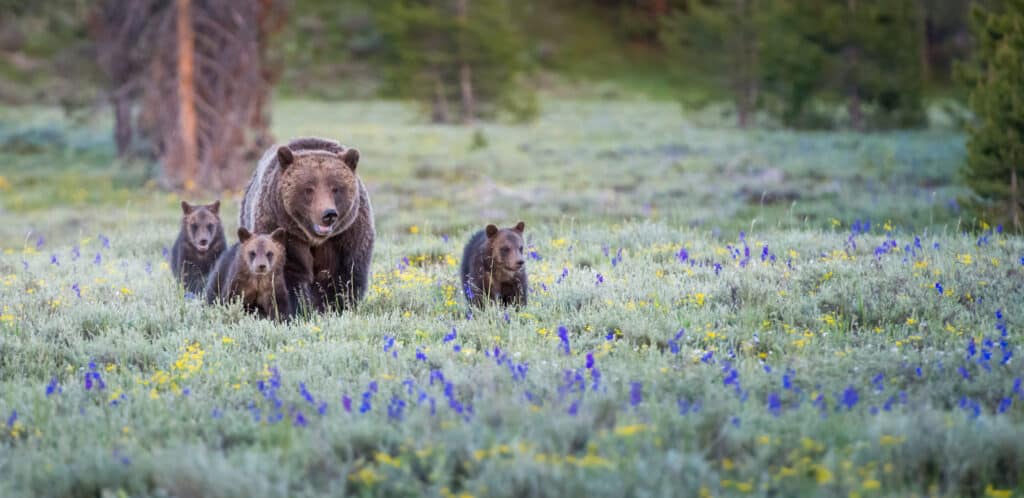Grizzly bears are some of the top predators in all of North America and pretty much rule the forests of the north! The United States has its fair share of grizzly bears, but nearly half of the bears found in North America are found in Canada alone. Today, we are going to learn about these Canadian grizzlies and find out just how many of them there are. Let’s get started!
How Many Grizzly Bears Live in Canada?
There are around 29,000 grizzly bears that live in Canada, all of which live in the western half of the country.
Canada is home to a huge population of grizzly bears that live in all sorts of climates and environments across the country. North America is home to more than 60,000 grizzly bears, of which close to 29,000 live in Canada. Alaska is home to the highest number of grizzly bears in North America, totaling around 30,000. Approximately 1,500 grizzly bears can be found in the lower 48 states, most of which live in Montana.

The salmon runs and huge amounts of shellfish along the coast of BC allow for some of the highest grizzly bear densities in the world.
©iStock.com/psahota
Where Do Grizzly Bears Live in Canada?
Currently, grizzly bears are found across Western Canada. The highest number of grizzly bears are located in British Columbia, with the rest living in Alberta, Yukon, Northwest Territories, and Nunavut. Of the roughly 29,000 grizzly bears in Canada, over half live in British Columbia. Because of the access to the Pacific Ocean, salmon runs, and more, BC is a much more fertile region for a creature that needs a lot of nutrition in order to thrive. The salmon runs and huge amounts of shellfish along the coast of BC allow some of the highest grizzly bear densities in the world. Sustaining a large number of these huge creatures is only possible through a special relationship with the ocean.
There are around 7,000 bears in the Yukon, 5,100 in the Northwest Territories, and 1,000 in Alberta.
Unlike the lower 48 states, however, grizzly bears in Canada do have important migration paths. These paths are known as corridors, and one of the most important is the Frog Bear Conservation Corridor and the Luxor Linkage Conservation Area.

Grizzly bear populations have been critically threatened and their historical range reduced.
©iStock.com/Matthew James Ferguson
The Historic Range of Grizzly Bears in Canada
Since hunting practices and territory destruction caused by humans, grizzly bear populations have been critically threatened and their historical range reduced. In fact, grizzly bears only inhabit around 50% of their historical range. Incredibly, grizzly bears once roamed from deep into Mexico and as far as the northern tip of Alaska.
Since this population and range reduction, certain bear populations have been genetically isolated.
Grizzly bears in BC’s Darkwoods Conservation Area had become genetically isolated – cut off from other nearby grizzly populations. Thanks to conservation efforts by NCC and others to protect and maintain safe habitat corridors, these bears are starting to reconnect with neighbouring populations.
Nature Conservancy
Residential and industrial development can easily segment the natural corridors that these bears live and travel through, causing further issues. Thankfully, the hard work being done by conservation groups is helping to ensure these corridors remain open and populations continue to recover.

Most grizzly bear attacks involve a mother with cubs so if you see cubs, back away and do not engage.
©iStock.com/Jillian Cooper
What Kind of Habitat Do Grizzly Bears Live In?
Grizzly bears are extremely diverse in their habitat preferences, especially in Canada. The country is home to dense boreal rainforests, coastal feeding grounds, prairies, and mountain tundras, all of which can house grizzly bears.
The favored habitat for grizzlies is food-rich places, usually on the coast. Wherever there are plentiful amounts of shellfish and salmon, grizzly bears can reside in high numbers. Outside of favored coastal habitats, grizzly bears live in most forests, grasslands, and even Arctic tundra! In the tundra, grizzly bears are occasionally known to interact with polar bears. These interactions are quite rare, and almost exclusively occur in the Northwest Territories in the Canadian Arctic.
If you happen to be in grizzly bear territory, there are a few tips that you should follow:
- Always make plenty of noise to ensure all bears in the area know where you are
- Never approach a bear
- If you see cubs, back away and do not engage. Most grizzly bear attacks involve a mother with cubs.
- Always follow proper food protocols when camping. If a bear wanders into camp looking for food, you don’t want them looking in your tent only to find you!
Generally, grizzly bears aren’t interested in messing with humans and will avoid us when given the chance.
Up Next
- Grizzly Bear Population by State
- Grizzly Bear Lifespan: How Long Do Grizzly Bears Live?
- Grizzly Bear vs. Great White Shark: Which Encounter Is More Dangerous?
The photo featured at the top of this post is © Steve Boice/Shutterstock.com
Sources
- Nature Conservancy Canada, Available here: https://www.natureconservancy.ca/en/what-we-do/resource-centre/featured-species/mammals/grizzly-bear.html#:~:text=More%20than%20half%20of%20Canada%27s,to%20high%2Delevation%20alpine%20environments.
- COMMITTEE ON THE STATUS OF ENDANGERED WILDLIFE IN CANADA , Available here: https://www.sararegistry.gc.ca/virtual_sara/files/cosewic/sr_grizzly_bear_e.pdf
- The National Wildlife Federation, Available here: https://www.nwf.org/Educational-Resources/Wildlife-Guide/Mammals/Grizzly-Bear
Thank you for reading! Have some feedback for us? Contact the AZ Animals editorial team.






